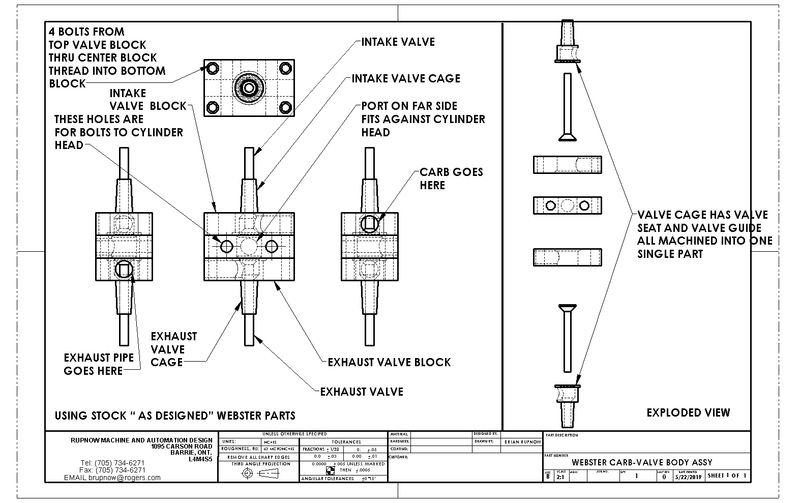I spent entirely too long deciding what to build for my first IC engine and finally decided to go with the Webster while waiting for George Britnell to finish his plans for the Holt 75.
Last weekend (11th/12th) was spent tracking down and ordering materials and I had it all by Friday. I didn't get everything, but enough to do a really good start on the engine. In particular, the parts labelled brass and bronze seemed hard to get small pieces of. I need to find a good source for that.
Found and ordered the two gears. My usual source for metals has mostly been Online Metals, but I kept coming up with sizes and costs way beyond what I hoped to pay. With eBay and a seller called USA Metal Online, I was able to save quite a bit over Online Metals for the 3/8 and 5/16" aluminum plates. I bought several smaller pieces from Hobby Metal Kits, but probably saved the most looking for a flywheel blank. The drawing says "CRS or Cast Iron", and the best I was doing was around $33 before shipping for a piece about 2" long and comfortably over 3.75" diameter of 1018 CRS. This was both Online Metals and some eBay searches. Then I ran into a different seller on eBay who had a chunk of what he called D2 tool steel at $18.75 including shipping. I figured the important part was the specific gravity of steel vs. aluminum and bought the D2 blank.
Everything I bought is in and I'm going through the drawings to figure out how to do things, but there's one thing I did that's new to me. The vinegar and salt solution for de-rusting steel really worked.
Of the things I bought, the only thing that was rusty was the flywheel blank and it was totally rusted on the front, back and sides. Since it's going onto the lathe to get cut, that didn't really matter, but I wanted to try that trick. So into a plastic container, covered with white vinegar, and some salt because I didn't know exactly how much vinegar was in the container. After 24 hours it looks like steel. All the surface rust came off. This thing was completely rust colored, without a single spot that was this color. There was really no scrubbing to get to this point. The rust just lifted off.

My process is different than most of yours. My mills are both CNC, so I either have to draw the parts up in 3D CAD so that I can create tool paths, or I have to get coordinates of every point on the drawings so I can enter points for holes, or start and stop points on straight cuts. I won't be going very fast.
Last weekend (11th/12th) was spent tracking down and ordering materials and I had it all by Friday. I didn't get everything, but enough to do a really good start on the engine. In particular, the parts labelled brass and bronze seemed hard to get small pieces of. I need to find a good source for that.
Found and ordered the two gears. My usual source for metals has mostly been Online Metals, but I kept coming up with sizes and costs way beyond what I hoped to pay. With eBay and a seller called USA Metal Online, I was able to save quite a bit over Online Metals for the 3/8 and 5/16" aluminum plates. I bought several smaller pieces from Hobby Metal Kits, but probably saved the most looking for a flywheel blank. The drawing says "CRS or Cast Iron", and the best I was doing was around $33 before shipping for a piece about 2" long and comfortably over 3.75" diameter of 1018 CRS. This was both Online Metals and some eBay searches. Then I ran into a different seller on eBay who had a chunk of what he called D2 tool steel at $18.75 including shipping. I figured the important part was the specific gravity of steel vs. aluminum and bought the D2 blank.
Everything I bought is in and I'm going through the drawings to figure out how to do things, but there's one thing I did that's new to me. The vinegar and salt solution for de-rusting steel really worked.
Of the things I bought, the only thing that was rusty was the flywheel blank and it was totally rusted on the front, back and sides. Since it's going onto the lathe to get cut, that didn't really matter, but I wanted to try that trick. So into a plastic container, covered with white vinegar, and some salt because I didn't know exactly how much vinegar was in the container. After 24 hours it looks like steel. All the surface rust came off. This thing was completely rust colored, without a single spot that was this color. There was really no scrubbing to get to this point. The rust just lifted off.

My process is different than most of yours. My mills are both CNC, so I either have to draw the parts up in 3D CAD so that I can create tool paths, or I have to get coordinates of every point on the drawings so I can enter points for holes, or start and stop points on straight cuts. I won't be going very fast.




































































